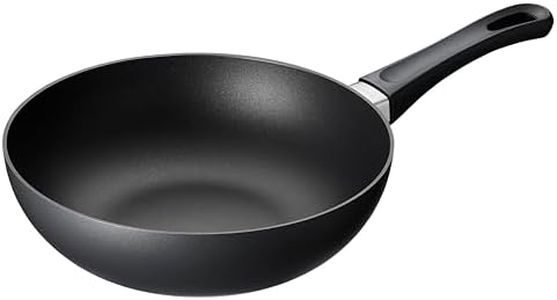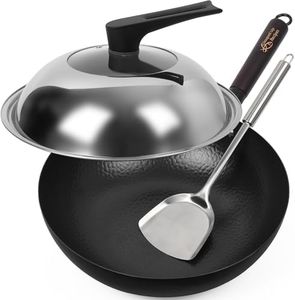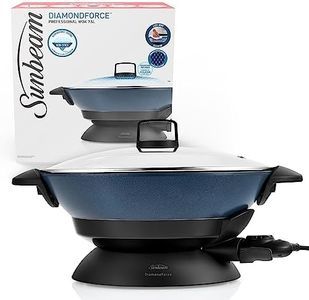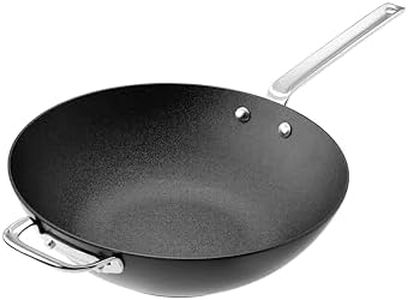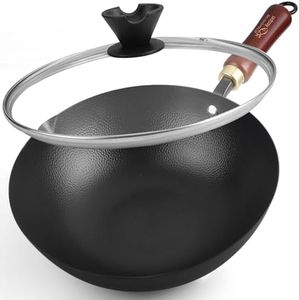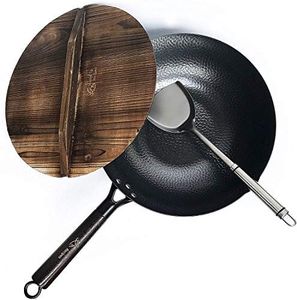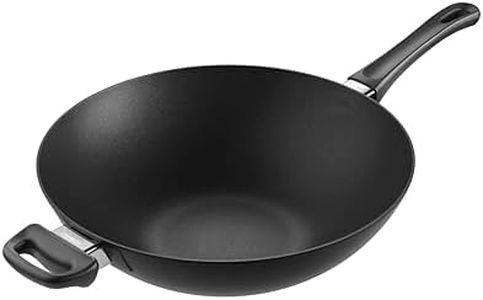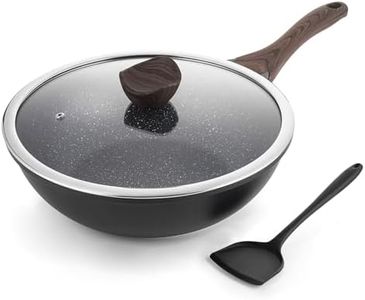We Use CookiesWe use cookies to enhance the security, performance,
functionality and for analytical and promotional activities. By continuing to browse this site you
are agreeing to our privacy policy
10 Best Induction Wok
From leading brands and best sellers available on the web.Buying Guide for the Best Induction Wok
Shopping for an induction wok can be surprisingly rewarding once you know what to look for. Induction woks are designed to heat up quickly and efficiently using electromagnetic energy, making them different from traditional woks. Because induction burners require special materials and design, it's important to make sure the wok you choose is truly compatible with your induction cooktop. Start by thinking about what kind of cooking you'll be doing—whether it's stir-frying, deep frying, steaming, or something else—then look at the key features that can affect your experience and results.Induction CompatibilityInduction compatibility means that the wok is designed to work with induction cooktops, which heat the pan through magnetic energy rather than direct flame or electric coils. Not all woks are compatible with induction, so look for a flat-bottomed wok with a magnetic base (usually made of ferrous metals). You can test if a wok is induction-ready by seeing if a magnet sticks to its bottom. If you want a wok for quick, even heating on your induction cooktop, make sure it's described as induction-compatible.
MaterialThe material of the wok affects how quickly it heats, how well it holds heat, and how food cooks. Common options include carbon steel, stainless steel, and cast iron with an induction-friendly base. Carbon steel is lightweight and heats up fast, making it good for quick stir-fries, while stainless steel is easier to maintain and less likely to rust. Cast iron retains heat well for slower cooking, but it's heavier. Pick a material based on the balance you want between speed, ease of maintenance, and the types of dishes you’ll prepare most often.
Shape (Flat or Round Bottom)Traditional woks have round bottoms, but for induction cooking, a flat-bottomed wok is necessary to ensure good contact with the cooktop. Flat bottoms allow the induction burner to transfer heat efficiently, while round-bottomed woks might not heat evenly or work at all. For best results, always choose a flat-bottom wok for induction use—even if you prefer the feel of a traditional wok, the flat design is essential for consistent cooking on induction surfaces.
Size (Diameter and Depth)The size of your wok will influence how much food you can cook at once and how easy it is to use. Woks typically range from 11 to 14 inches in diameter. Smaller woks (around 11-12 inches) are good for cooking for one or two people and fit better on smaller burners, while larger woks (13-14 inches) are better for families or batch cooking. The depth also affects how much food you can toss without spilling. Choose a size that suits both your stovetop space and the number of people you usually cook for.
Handle TypeInduction woks come with either a single long handle, two loop handles, or sometimes a combination. A single long handle makes tossing and stirring easier, especially with lighter materials like carbon steel. Loop handles offer better grip, especially for heavy woks or when cooking large quantities. Think about your cooking style and comfort—if you like to toss ingredients, a long handle is helpful. If you often move the wok off the stovetop, loop handles provide a steady hold.
Lid InclusionSome woks come with lids, which can be helpful for simmering, steaming, or keeping food warm. While not essential for all wok cooking, a lid can add versatility. If you plan on steaming or want to use your wok as a multi-cooker, look for a model that includes a lid. If you primarily do quick stir-fries, you may not need one, but having a lid can still be a useful bonus.
Nonstick CoatingNonstick coatings help food release easily and make cleaning simpler, but they can limit how hot you can cook and may wear out over time with metal utensils. If you’re new to wok cooking and like easy cleanup, a nonstick option might help avoid sticking issues. However, if you want to use high heat and develop a natural seasoning over time, consider a carbon steel or cast iron wok without nonstick. Your skill level and cooking habits should guide your choice here.


